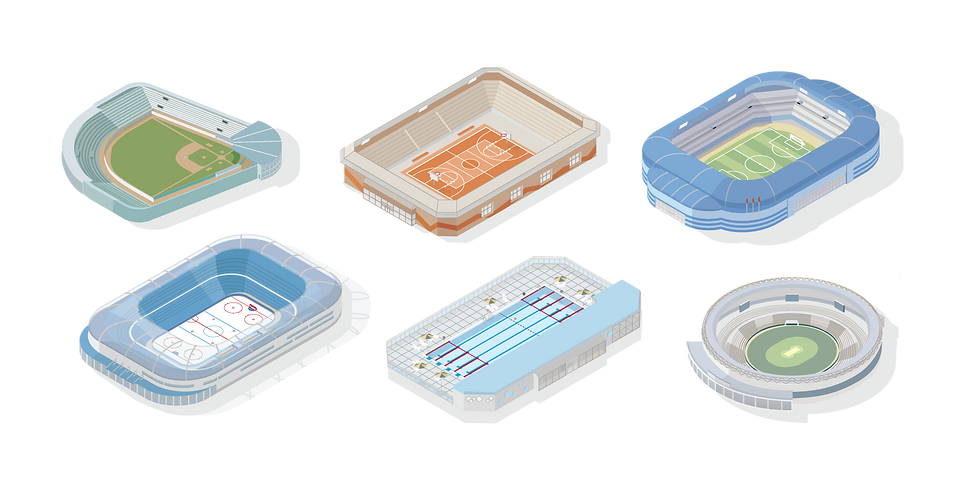Designing Football Stadium Acoustics for an Unforgettable Experience
- Serkan Duman
- Aug 24, 2023
- 3 min read
In the world of sports, football holds a special place in the hearts of millions of fans. It's not just about the game; it's about the electrifying atmosphere that engulfs the stadium, creating an experience that resonates with supporters for a lifetime. Behind the scenes, one crucial aspect that plays a significant role in shaping this memorable ambiance is the design of football stadium acoustics. In this article, we delve into the art and science of crafting acoustic environments that enhance the excitement, intensity, and connection between fans, players, and the game itself.

Understanding Acoustics
Acoustics is the study of sound and its behavior in different environments. When it comes to football stadiums, acoustics can profoundly influence the overall experience for fans and players alike. From the eruption of cheers to the deafening roar of a crowd, the design of stadium acoustics has a direct impact on how these sounds are perceived, transmitted, and experienced by all.

Key Considerations in Designing Football Stadium Acoustics

Shape and Layout
The architectural design of a stadium plays a vital role in shaping its acoustics. Stadiums with enclosed bowl-like structures tend to trap sound waves, allowing for better reverberation and amplification. However, open-air stadiums present unique challenges, as sound can easily disperse and lose intensity. Architects must consider the geometry, seating arrangement, and overall layout to optimize the acoustic characteristics of the stadium.
Material Selection

The choice of construction materials significantly affects the acoustic properties of a stadium. Hard surfaces, such as concrete and metal, reflect sound waves, enhancing their reach and creating a vibrant atmosphere. On the other hand, incorporating absorbent materials like acoustic panels or strategically placed soft surfaces can help control excessive reverberation and improve speech intelligibility, ensuring that important announcements and instructions are clearly heard.
Sound System Integration
Modern football stadiums rely on advanced sound reinforcement systems to amplify sound and enhance the overall experience. These systems consist of strategically placed loudspeakers, carefully calibrated to provide even coverage across the entire stadium. Integrated sound systems must be designed to minimize delays and ensure synchronicity, enabling fans to hear the roar of the crowd as a unified entity, fostering a sense of togetherness.

Crowd Management

Creating an immersive acoustic experience requires an understanding of crowd behavior. Designers must consider the capacity, demographics, and behavior patterns of the fans. By strategically locating seating sections for the most passionate fans, known as "ultras" or "supporters' sections," the acoustic energy can be concentrated, resulting in a more intense and exhilarating atmosphere. However, it is essential to strike a balance to avoid excessive noise levels that may disrupt the game or cause discomfort to spectators.
Benefits of Well-Designed Football Stadium Acoustics
Enhanced Atmosphere: A well-designed acoustic environment has the power to amplify the emotional intensity and excitement of a football match, fostering a sense of unity and passion among fans and players.
Player Encouragement

The roar of the crowd can act as a catalyst, motivating players and fueling their performance. An acoustically optimized stadium can provide players with a tremendous psychological advantage by creating an intimidating and inspiring atmosphere.
Memorable Fan Experience
By carefully crafting the acoustics, stadium designers can create an unforgettable experience for fans, leaving them with cherished memories of being part of something larger than themselves.
Branding and Revenue Opportunities
A stadium renowned for its exceptional acoustics can become a trademark for a club or franchise. Moreover, it can attract a wide range of events such as concerts, increasing revenue streams for the stadium and the surrounding area.
For Desmus team designing football stadium acoustics is both an art and a science. It requires a comprehensive understanding of the principles of acoustics, architectural design, and human behavior. By considering factors such as shape, materials, sound systems, and crowd management, stadiums can be transformed into captivating environments that amplify the energy and passion of the game. Well-designed acoustics not only enhance the overall experience for fans and players but also leave an indelible mark on the sport's history.



Comments